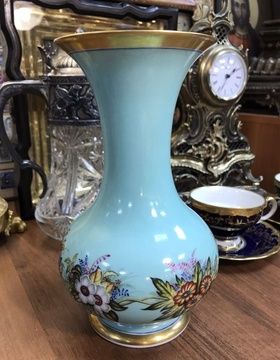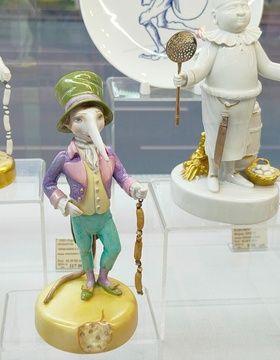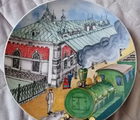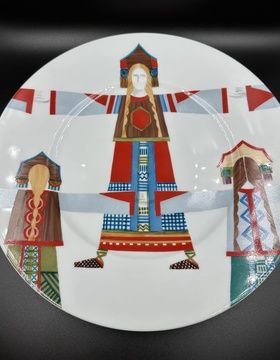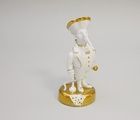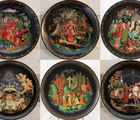
Императорский фарфоровый завод - одно из старейших в Европе, первое и одно из крупнейших в России предприятий по производству художественных фарфоровых изделий. Расположен в Санкт-Петербурге, основан в 1744 году.
Первоначально именовался «Невской порцелиновой мануфактурой», с 1765 - Императорский фарфоровый завод, с 1917 - Государственный фарфоровый завод (ГФЗ - аббревиатура клейма). С 1924 года - Ленинградский фарфоровый завод. В 1925 году заводу в связи с 200-летием Российской академии наук было присвоено имя М. В. Ломоносова; предприятие получило официальное наименование - Ленинградский фарфоровый завод имени М. В. Ломоносова, наряду с которым имела употребление краткая форма - Ломоносовский фарфоровый завод (ЛФЗ - аббревиатура клейма истолковывалась и как Ленинградский фарфоровый завод) - до 2005 года.
Императорский фарфоровый завод. Времена Николая I.
В 1825 году после кончины Александра I на престол взошел Николай I, его родной брат. С приходом нового императора началась эпоха больших изменений в политической, экономической и социальной сферах жизни страны. Основными принципами правления Николая I считаются порядок, строгая, безусловная законность, отсутствие всезнайства и противоречий, взаимосвязанность одного с другим, подчинение всех одной определённой цели, наличие определенного предназначения для каждого.
Изменения не могли не коснуться и одного из крупнейших предприятий того времени - Императорского фарфорового завода. В 1826 году вместо безвременно ушедшего графа Дмитрия Александровича Гурьева на пост главного начальника Кабинета Его Императорского Величества и Министра Министерства Императорского Двора назначается князь Пётр Михайлович Волконский, в ведение которого попадает и Императорский фарфоровый завод.
В отличие от своих предшественников, Гурьева и Юсупова, Волконский отстраняется от непосредственного ведения дел и создает промежуточную инстанцию по управлению четырьмя производствами: Императорским фарфоровым, Стеклянным, Выборгским зеркальным заводами и Шпалерной мануфактурой. Возглавлял это ведомство один человек, назначавшийся Кабинетом Его Императорского Величества. Управление осуществлялось на основании инструкции, выданной тем же Кабинетом. На местах же производствами руководили директора, которых утверждал министр императорского двора. Также были разработаны новые уставы для предприятий и заменен штат. Изменился и подход к финансированию завода. Теперь из Кабинета Его Императорского Величества выдавался аванс в счёт изготовляемых изделий. Эта мера существенным образом влияла на сроки изготовления, поскольку теперь не было необходимости вести долгую переписку с министерством финансов с обоснованием необходимости получить средства.
Но, как это обычно бывает в России, реформы провели, а система администрирования осталась прежней. Каких-либо кардинальных изменений на производстве в период управления Волконским не произошло. Положение Императорского фарфорового завода оставалось затруднительным, несмотря на все усилия руководства вывести предприятие из кризиса.
В 1844 году состоялось празднование столетия со дня основания Императорского фарфорового завода. По этому случаю было досконально описано существующее на тот момент устройство фабрики. Мануфактура состояла из двух основных подразделений: «искусственного» и «хозяйственного». В первый входили лабораторное, гончарное, живописное отделения, а также отделения состава масс, обжига вещей и белых изделий. К хозяйственному подразделению были отнесены: контора с комиссарами, лазарет, школа и полицейская часть. Каждое из подобных отделений подразделялись ещё на массу небольших отделов, отвечающих за различные стороны работы фабрики. Изучив архивные документы, можно сказать, что в период правления Николая I Императорский фарфоровый завод представлял собой крупное предприятие с разветвлённой схемой управления, большим штатом сотрудников и основательным количеством техники (формовочные машины, горны и т.д.). Этот порядок вещей сохранялся на протяжении всего времени правления Николая I.
Так же одним из важных аспектов, существенно повлиявших на существование завода в тот период, стало значительное сокращение частной продажи изделий, которое активно развивалось при прежнем Императоре. Но, несмотря на то, что повсеместно закрывались лавки ИФЗ и, более того, прекратилось приносившее неплохую прибыль участие в ярмарках, выпуск продукции на заводе не только не уменьшился, но и напротив, увеличился благодаря возросшим потребностям Императорского Двора и различных придворных учреждений. Основные масса заказов была на производство ординарных столовых сервизов для повседневного пользования, однако немалую долю составляли и заказы на эксклюзивные произведения.
Претерпела изменения и техническая составляющая производства. Так данное еще Екатериной II указание употреблять в производство только отечественную глину впервые было нарушено, и к использованию разрешили французскую (лиможскую) глину. Это решение было обусловлено многолетними тщетными попытками добиться от фарфоровой массы свойств, идентичных европейским образцам. С началом использования лиможской глины можно отметить почти полное сходство отечественного фарфора с английским и французским по белизне, тонкости и прочности. Благодаря постоянно ведущимся опытам, был значительно улучшен обжиг. Процесс нанесения позолоты подвергся значительным изменениям, что позволило сократить расход материала на 15%. Кроме золочения, в оформлении изделий также стали использовать платину.
К столетию производства был открыт музей, в котором были выставлены лучшие изделия завода.
Так же Императорский фарфоровый завод впервые стал участвовать в зарубежных выставках. Известно, что 1851 году продукция мануфактуры была представлена на Лондонской международной выставке. Художественное оформление изделий этого периода было богатым и разнообразным. В росписи были отражены стили различных эпох, но акцент всё же делался на сюжеты из повседневной жизни. Мастера завода активно обращались к сюжетам античности, восточной и русской древности, искали вдохновения в итальянских, французских гравюрах. Кроме того, изменяющаяся социальная структура общества открыла новый потребительский класс, которому были чужды грандиозные и помпезные изделия. Возросла потребность в более простой и лаконичной продукции, именно поэтому в оформлении изделий Императорского фарфорового завода появляются черты реализма, как направления в искусстве. На фоне возросшей любви к различным литературным персонажам, завод не упускает момента и выпускает статуэтки в виде полюбившихся героев той эпохи, таких например как героев произведений Вальтера Скотта, Александра Дюма и т. п.
Также Императорский фарфоровый завод существенно расширяет ассортимент. Теперь в цехах при желании можно найти практически всё: начиная от бисквитных медальонов и кончая фарфоровой мебелью. Однако, основную часть выпускаемой продукции составляют всё те же столовые и чайные сервизы и вазы.
Для коллекционеров будет полезно знать, что вазы николаевского периода подразделялись на три основных формы:
- вазы в стиле мейссенского рококо с обилием скульптурных украшений и цветочным орнаментом без сюжетных живописных картин;
- кратерообразные, чашевидные вазы с ножкой, форма которых напоминает цилиндр иногда слегка вогнутый, с короткой шейкой и с низко отходящими ручками. Данная форма в соответствии с терминологией того времени носит название «медицис»;
- вытянутые вазы с оплечьями, длинной шейкой и узким раструбом, то есть вазы, напоминающие античные урны и вазы.
Обычно эти вазы были украшены живописными рисунками с двух сторон, скульптурным орнаментом по бокам и, зачастую обрамлены бронзовой оправой.
Резюмируя события того времени, можно подвести итог, что, несмотря на определённые трудности в развитии и работе Императорского фарфорового завода, заметен неподдельный интерес и потребность в его продукции. Несомненно, в эпоху правления Николая I ИФЗ в значительной степени расширил свой ассортимент продукции, мастера стали использовать более разнообразное оформление изделий в соответствии с требованиями моды и европейскими образцами.
Аукцион искусства и старины art-picture.ru предоставляет возможность покупки
приобрести представленны лоты по теме "Императорский фарфоровый завод"

